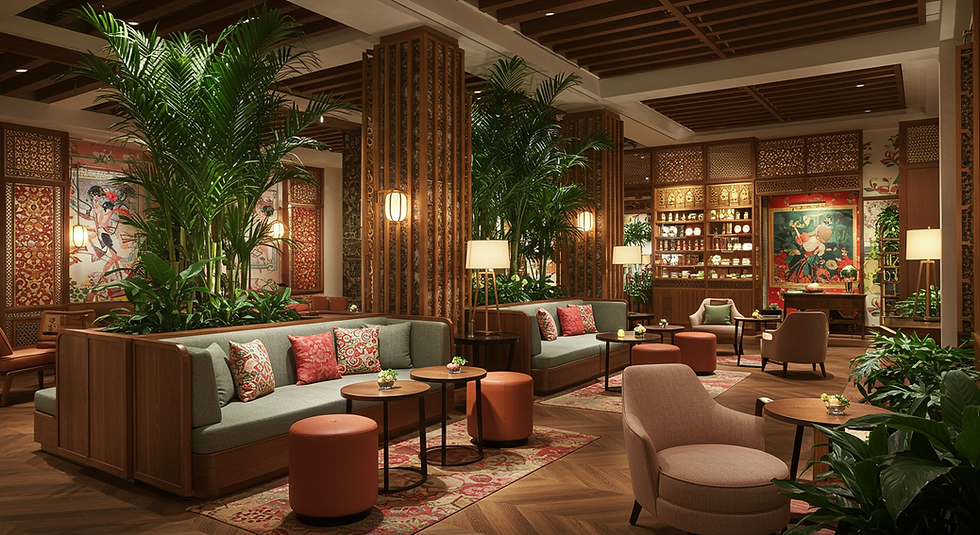Hospitality Interior Design Trends in Singapore
- Weiliang
- Aug 27
- 4 min read
Updated: Sep 2
The hospitality industry in Singapore is constantly evolving. Hotels, resorts, and serviced apartments are competing not only on services but also on design and guest experience. A well-designed interior can attract guests, create memorable stays, and reflect the brand’s personality. Renovating or updating your hospitality space is essential to staying relevant and competitive. This guide highlights the latest hospitality interior design trends in Singapore and how they can be implemented effectively.
Focus on Sustainability
Sustainability has become a major priority in hospitality design. Guests are increasingly aware of eco-friendly practices, and sustainable interiors reflect positively on the brand. Use energy-efficient lighting, water-saving fixtures, and recycled or renewable materials in renovation projects. Hotels can also implement smart technology to monitor energy usage and reduce waste. Sustainable design not only reduces environmental impact but also lowers long-term operational costs. For property owners, investing in eco-conscious interiors shows responsibility and modern thinking.
Incorporate Local Culture and Identity

Incorporating Singaporean heritage and local culture creates a unique and memorable experience for guests. Designers are blending traditional motifs, textures, and materials with modern aesthetics. For example, using Peranakan patterns, tropical plants, or locally sourced wood adds authenticity and charm. Cultural integration can be subtle, like artwork and decor, or more prominent, such as furniture and lighting inspired by local designs. This trend connects visitors to the city and enhances brand storytelling.
Use Flexible and Multi-Functional Spaces
Hotels and resorts are increasingly designing spaces that serve multiple purposes. Lobbies can double as co-working areas, restaurants can host events, and lounges can transform into social hubs. Flexible spaces optimise usage and accommodate more guests without increasing floor space. Modular furniture, movable partitions, and adaptable layouts make these transformations smooth and functional. This approach is especially important in small boutique hotels or urban properties.
Integrate Biophilic Design
Biophilic design, bringing nature indoors, is a growing trend in hospitality interiors. Indoor plants, vertical gardens, natural light, and water features enhance the ambience and promote well-being. Many hotels now work with professional renovation services to seamlessly integrate these natural elements into their spaces. Guests feel calmer and more relaxed in spaces that connect with nature. Biophilic elements can also improve air quality and reduce stress. In Singapore, tropical plants, bamboo accents, and water features are popular ways to integrate this trend.
Create Relaxing and Wellness
Wellness-focused design has become increasingly important for hospitality spaces. Comfortable furniture, ergonomic layouts, and quiet zones enhance guest satisfaction. Materials like soft textiles, warm lighting, and acoustic panels create a relaxing environment. Hotels can also offer wellness areas, such as yoga zones, spa corners, or meditation rooms, to attract health-conscious travellers. Prioritising comfort and wellness ensures guests enjoy longer, more satisfying stays.
Invest in Smart Technology
Smart technology is transforming hospitality interiors. Automated lighting, climate control, mobile check-in systems, and keyless entry provide convenience and a modern feel. Hotels can integrate digital concierge services, smart room management, and energy-saving systems to enhance operational efficiency. Guests appreciate seamless technology that makes their stay smoother and more personalised. Exploring the role of Technology in Commercial Renovations can also give hospitality businesses fresh insights into how modern upgrades improve both guest experience and long-term efficiency.
Play with Colours, Textures, and Patterns
Bold colours, textured materials, and statement patterns are popular in modern hospitality design. Designers are experimenting with rich colours, tactile surfaces, and layered textures to create depth and visual interest. Accent walls, patterned tiles, velvet upholstery, and mixed materials can make spaces memorable and Instagram-worthy. However, it is important to balance bold design with functionality and comfort.
Use Minimalist Design Strategically
Minimalism remains popular, especially in boutique hotels and modern hospitality concepts. Clean lines, uncluttered spaces, and neutral colours create a sophisticated and calming environment. Minimalist interiors emphasise quality over quantity, allowing key design elements to stand out. This style works well in smaller spaces, helping them feel open and airy, while also highlighting furniture and decor features.
Focus on Guest Experience
Ultimately, hospitality interior design is about enhancing the guest experience. Thoughtful layouts, comfortable seating, engaging visuals, and efficient circulation contribute to positive experiences. Small touches like curated artwork, ambient lighting, and personalised service areas make guests feel valued and welcome. Combining design trends with a focus on user experience creates spaces that are both functional and memorable.
Conclusion
Hospitality interior design in Singapore is evolving to meet guest expectations for comfort, sustainability, and memorable experiences. From biophilic elements and wellness-focused spaces to flexible layouts and smart technology, modern trends focus on both style and practicality. By applying these ideas thoughtfully, hotels and resorts can attract more guests, improve satisfaction, and build a strong brand presence in the competitive Singapore market.
FAQs
1. What are the latest hospitality interior design trends in Singapore?
Sustainability, biophilic design, wellness-focused interiors, flexible spaces, minimalist decor, bold textures, and smart technology are key trends shaping the hospitality sector.
2. How can hotels implement sustainable design?
Use energy-efficient lighting, recycled materials, water-saving fixtures, and smart systems. Incorporating greenery and eco-friendly furniture also supports sustainability goals.
3. Why is biophilic design important in hospitality?
Biophilic design connects guests to nature, reduces stress, improves air quality, and creates a relaxing atmosphere. It enhances overall guest satisfaction and wellness.
4. How can I renovate a hotel without affecting guests?
Phased renovation, night work, or temporarily closing specific areas can minimise disruption. Working with professional renovation services ensures smooth execution.
5. What should I look for in renovation services in Singapore?
Experience in hospitality projects, understanding of design trends, knowledge of local regulations, and a strong portfolio. Clear communication and project management are also essential.



Comments